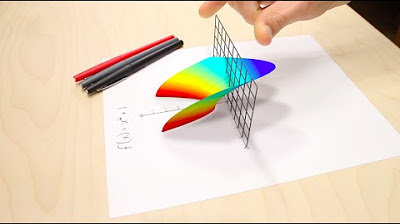The Most Beautiful Equation
Summary
TLDREuler's Identity, a profound equation in mathematics, elegantly links five fundamental constants: 0, 1, pi, the imaginary unit i, and e. This video script delves into the concepts of pi, radians, complex numbers, and derivatives, explaining how they contribute to the identity. It explores the Taylor series for sine, cosine, and e, leading to the revelation that e^(iπ) + 1 = 0, a testament to the beauty and interconnectedness of mathematical ideas.
Takeaways
- 📐 Euler's Identity is a celebrated equation that connects five fundamental mathematical constants: 0, 1, π, i, and e.
- 📈 Pi (π) is a geometric constant representing the ratio of a circle's circumference to its diameter, approximately 3.14.
- 🔄 The imaginary unit i is defined as the square root of -1, allowing for the square roots of negative numbers.
- 📊 Radians are a measure of angles where a full circle is 2π radians, commonly used in calculus and advanced mathematics.
- 📚 Derivatives describe the rate of change of a function at a specific point and are calculated using limits.
- 📈 The derivative of a function can often be found using rules like the constant rule, sum rule, and power rule.
- 🔢 The Taylor series represents functions as infinite sums of powers of x, useful for understanding functions like sine and cosine.
- 📂 The number e (Euler's number) is a special constant approximately equal to 2.718, and its derivative is itself multiplied by 1.
- 🔄 Euler's Identity can be understood by examining the Taylor series for sine and cosine, and how they relate to e^(ix).
- 🔢 By substituting x with π in the Taylor series for e^(ix), we arrive at the conclusion that e^(iπ) + 1 = 0.
- 🎓 Brilliant.org offers interactive learning experiences in math, data science, and computer science, including lessons on complex numbers and Euler's Identity.
Q & A
What is Euler's Identity and why is it significant?
-Euler's Identity is the equation e^(iπ) + 1 = 0, which is significant because it elegantly links five fundamental mathematical constants: 0, 1, e, i, and π. It showcases the beauty and interconnectedness of mathematics.
What are the two main ways to measure angles and how do they relate to π?
-The two main ways to measure angles are in degrees and radians. A full circle is 360° in degrees and 2π radians in radians. This relationship is important in fields like calculus and advanced mathematics where angles are typically measured in radians.
What is the imaginary unit i and how is it defined?
-The imaginary unit i is defined as the square root of -1. It allows for the definition of complex numbers and the ability to find square roots of negative numbers, thus expanding the realm of numbers beyond the real numbers.
How does the concept of derivatives relate to Euler's Identity?
-Derivatives describe the rate of change of a function at a given point. They are crucial in understanding the behavior of functions like sine and cosine, which are part of the Euler's Identity. The derivative of sine is cosine, and vice versa, which is reflected in the identity when considering the Taylor series expansions.
What is the number e and how is it derived?
-The number e is a special constant approximately equal to 2.718. It is derived from the exponential function whose derivative is equal to itself, meaning the derivative of e^x is e^x. The value of e can be approximated using its Taylor series.
How does the Taylor series for sine and cosine of x relate to Euler's Identity?
-The Taylor series for sine and cosine of x can be combined and multiplied by i to match the form of e^x. This shows that e^(ix) is equal to the cosine of x plus i times the sine of x, which leads to Euler's Identity when x is substituted with π.
What is the role of the constant rule in calculus?
-The constant rule states that the derivative of a function multiplied by a constant is equal to the derivative of that function multiplied by the same constant. This rule simplifies the process of finding derivatives of functions that are products of constants and other functions.
What is the sum rule in differentiation?
-The sum rule states that the derivative of a sum of functions is equal to the sum of the derivatives of those functions individually. This rule allows for the differentiation of more complex functions by breaking them down into simpler components.
What is the power rule in differentiation?
-The power rule states that the derivative of a function of the form x to the power of a is a times x to the power of a-1. This rule provides a straightforward method for finding the derivatives of power functions.
How does the concept of limits play a role in understanding derivatives?
-Limits are fundamental to the definition of a derivative. The derivative of a function at a point is defined as the limit of the difference quotient as the interval between two points approaches zero. This concept allows for the precise calculation of rates of change at specific points.
What is the relationship between the derivative of sine and cosine functions?
-The derivative of the sine function is the cosine function, and the derivative of the cosine function is the negative sine function. This relationship is derived from the definition of derivatives and is crucial in understanding the behavior of these trigonometric functions.
Outlines

此内容仅限付费用户访问。 请升级后访问。
立即升级Mindmap

此内容仅限付费用户访问。 请升级后访问。
立即升级Keywords

此内容仅限付费用户访问。 请升级后访问。
立即升级Highlights

此内容仅限付费用户访问。 请升级后访问。
立即升级Transcripts

此内容仅限付费用户访问。 请升级后访问。
立即升级浏览更多相关视频
5.0 / 5 (0 votes)






